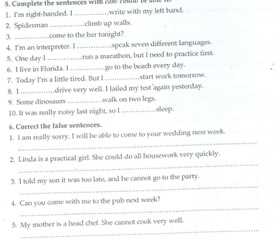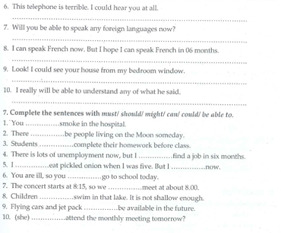mn giải đc bài nào thì giải nha
Hãy nhập câu hỏi của bạn vào đây, nếu là tài khoản VIP, bạn sẽ được ưu tiên trả lời.


3.
Do \(sin\left(x+k2\pi\right)=sinx\Rightarrow sin\left(x+2020\pi\right)=sinx\)
\(sin\left(\dfrac{\pi}{2}+x\right)=cos\left(\dfrac{\pi}{2}-\dfrac{\pi}{2}-x\right)=cos\left(-x\right)=cosx\)
\(A=\dfrac{sinx+sin3x+sin5x}{cosx+cos3x+cos5x}=\dfrac{sinx+sin5x+sin3x}{cosx+cos5x+cos3x}\)
\(=\dfrac{2sin3x.cosx+sin3x}{2cos3x.cosx+cos3x}=\dfrac{sin3x\left(2cosx+1\right)}{cos3x\left(2cosx+1\right)}\)
\(=\dfrac{sin3x}{cos3x}=tan3x\)
4.
a.
\(\overrightarrow{CB}=\left(2;-2\right)=2\left(1;-1\right)\)
Do đường thẳng d vuông góc BC nên nhận \(\left(1;-1\right)\) là 1 vtpt
Phương trình đường thẳng d đi qua \(A\left(-1;2\right)\) và có 1 vtpt là \(\left(1;-1\right)\) là:
\(1\left(x+1\right)-1\left(y-2\right)=0\Leftrightarrow x-y+3=0\)
b.
Gọi \(I\left(a;b\right)\) là tâm đường tròn, ta có \(\left\{{}\begin{matrix}\overrightarrow{AI}=\left(a+1;b-2\right)\\\overrightarrow{BI}=\left(a-3;b-2\right)\\\overrightarrow{CI}=\left(a-1;b-4\right)\end{matrix}\right.\)
\(\Rightarrow\left\{{}\begin{matrix}AI^2=\left(a+1\right)^2+\left(b-2\right)^2\\BI^2=\left(a-3\right)^2+\left(b-2\right)^2\\CI^2=\left(a-1\right)^2+\left(b-4\right)^2\end{matrix}\right.\)
Do I là tâm đường tròn qua 3 điểm nên: \(\left\{{}\begin{matrix}AI=BI\\AI=CI\end{matrix}\right.\) \(\Leftrightarrow\left\{{}\begin{matrix}AI^2=BI^2\\AI^2=CI^2\end{matrix}\right.\)
\(\Leftrightarrow\left\{{}\begin{matrix}\left(a+1\right)^2+\left(b-2\right)^2=\left(a-3\right)^2+\left(b-2\right)^2\\\left(a+1\right)^2+\left(b-2\right)^2=\left(a-1\right)^2+\left(b-4\right)^2\end{matrix}\right.\)
\(\Leftrightarrow\left\{{}\begin{matrix}8a=8\\4a+4b=12\end{matrix}\right.\) \(\Rightarrow\left\{{}\begin{matrix}a=1\\b=2\end{matrix}\right.\) \(\Rightarrow I\left(1;2\right)\)
\(\overrightarrow{AI}=\left(2;0\right)\Rightarrow R=AI=\sqrt{2^2+0^2}=2\)
Pt đường tròn có dạng:
\(\left(x-1\right)^2+\left(y-2\right)^2=4\)


a) x = 135 (2 góc đồng vi)
b) x = 90 vì góc K và góc H là 2 góc trong cùng phía, tính chất của 2 góc trong cùng phía là bù nhau nên ta có: 180 - 90 = 90



Exercise 2: Fill in the correct forms of adverbs and adjectives
1. Those shoes are (pretty)........prettier than.........................these ones.
2. Marissa is (young)...........younger than.....................I am.
3. Texas is (big)..............bigger than..................Arizona.
4. He is much (old).........older than ...............I expected.
5. During the volleyball game, the mothers seemed to be (energetic).............more energetic.................their daughters.
6. Planes fly (high).........higher than..................birds.
7. Nashla gets to school (early)........earlier than...................her sister Rosemary.
8. Frankie’s pitch this season was (bad).........worse than..................last season’s.
9. Dar. Rani’s office is (far)........farther......................down the block.
10. Apartment’s rentals in Brooklyn are (expensive).............the most expensive....................rentals in The Bronx.
Exercise 3: Put the verbs into correct forms using First or Second conditional sentences
1. If we (rent).............rent.........that big flat, we (have).............will have.........enough room for the dog.
2. I (buy)..........would buy............a huge house with a garden if I (win).............won.........the lottery.
3. If you (paint).........painted.............this room white it (be)..........would be............much lighter.
4. I (do)...........would do...........it myself if I (have).............had.........more time.
5. I (not be).........wouldn't be.............so broke if I (spend)............spent..........so much on going out.
6. Maybe if I (share)...........share...........a flat with friends, I (get on)..............will get on ........better with my parents.
7. I (can).............could.........travel next summer if I (have)........had................more money.
8. Carla (move).......would...............out of her shared flat if she (find)..............found........a job.
9. If my girlfriend (not have to).........didn't have to..........................work so hard, we (can)..............could........see each
other more often.
10. If I (go)..........went............to bed earlier, I (not be).......wouldn't be...............so tired all the time.
Exercise 4: Put the verbs into correct forms using The past simple tense, The past continuous tense or
The present perfect tense
1. My friend’s a great writer. He (write)has written lots of books so far.
2. We (not have)............didn't have.........a holiday last year, because there (not be)..........was not.. enough time for that.
3. The weather (be).......was........very good yesterday so Kelly (not stay)................didn't stay.................at home.
4. My hair is wet. I (just wash)have just washed it.
5. Is Sonia here? No, she (not come)hasn't come yet.
6. Do you know Martin’s sister? I (see)have seen her a few times but I have never spoken to her. Have You (ever speak)..ever spoken.........................to her? Yes, I
(meet)met her at a party last week. She’s very nice.
7. We (travel) have traveled around South America since June and (already
explore).........................have already explored........ an amazing historic site Machu Picchu in Peru.
8. Albert Einstein (be).......was...........the scientist who (develop)......developed..................the theory of relativity.
9. How long have you (use)..........used..............a bike to get around London? I (buy)..........bought..............this 2 weeks ago and I (ride)..........have ridden..............it every day since I got it.
10. My parents (live)..........have lived.......................in London since they (get married)............got married.................in 1975. They still adore this city.
Exercise 9: Write a short paragraph about a future means of transport, using the cues given.
Safe, environmentally friendly cars
1. Cars/ the future/ do less damage/ the environment/ and/ be equipped/ better safety devices/ limit/ number/accidents and deaths.
Cars in the future will do less damage to the environment and will be equipped better safety devices to limit the number of accidents and deaths.
2. Engines/ be powered/ by/ rubbish-fueled reactor/to make use/ all the waste we produce.
Engines will be powered by rubbish-fueled reactor to make use of all the waste we produce.
3. Petrol/ be replaced/ fuel cells/ separate hydrogen/ oxygen/ water.
Petrol will be replaced by fuel cells to separate hydrogen and oxygen in water.
4. Cars/ have sensors/ detect pedestrians/ other cars/ and/ have/ air cushions.
Cars will have sensors that detect pedestrians and other cars and will have air cushions.
5. Vehicles/ “talk”/ each other/ regulate flow/ it/ mean/ end/ traffic jams.
Vehicles can ''talk'' to each other to regulate flow, it means the end of traffic jams.(tham khảo c5)
6. Cars/ powered by fuel cells/ already developed.
Cars which are powered by fuel cells have already been developed.
7. We/ see/ this type of cars/ the roads/ twenty years.
We will see this type of cars on the roads in twenty years.
8. Environmental and safety improvements/ popular soon.
Environmental and safety improvements will be popular soon.

Bài 4:
a: Xét tứ giác ADBM có
E là trung điểm của DM
E là trung điểm của AB
Do đó: ADBM là hình bình hành
mà DA=DB
nên ADBM là hình thoi
b: Xét tứ giác ACDM có
DM//AC
DM=AC
Do đó: ACDM là hình bình hành

1: \(A=2\left(1+2+2^2\right)+...+2^{97}\left(1+2+2^2\right)+2^{100}\)
\(=7\left(2+...+2^{97}\right)+2^{100}\) chia 7 dư 2


 Mik đng cần gấp giải đc bài nào thì ha bài ấy nha!!!!C.ơn trc nha.
Mik đng cần gấp giải đc bài nào thì ha bài ấy nha!!!!C.ơn trc nha.







Bài 2:
Ta có
OA=OC => tg OAC cân tại O \(\Rightarrow\widehat{OCA}=\widehat{OAC}\) (1)
\(\Rightarrow\widehat{AOC}=180^o-\left(\widehat{OCA}+\widehat{OAC}\right)\) (2)
O'A=O'B => tg O'AB cân tại O' \(\Rightarrow\widehat{O'AB}=\widehat{O'BA}\) (3)
\(\Rightarrow\widehat{AO'B}=180^o-\left(\widehat{O'AB}+\widehat{O'BA}\right)\) (4)
\(\widehat{OAC}=\widehat{O'AB}\) (5)
Từ (1) (2) (3) (4) (5) \(\Rightarrow\widehat{AOC}=\widehat{AO'B}\)
Xét đường tròn (O)
\(sđ\widehat{AOC}=sđ\)cung AC (góc ở tâm)
Xét đường tròn (O')
\(sđ\widehat{AO'B}=sđ\) cung AB (góc ở tâm)
=> sđ cung AC = sđ cung AB
\(\Rightarrow sđ\widehat{ACy}=\frac{1}{2}sđ\)cung AC \(=\frac{1}{2}sđ\) cung AB \(=sđ\widehat{ABx}\) (góc nội tiếp đường tròn)
=> Bx//Cy (Hai đường thẳng bị cắt bởi đường thẳng thứ 3 tạo thành 2 góc sole trong = nhau thì // với nhau) (đpcm)